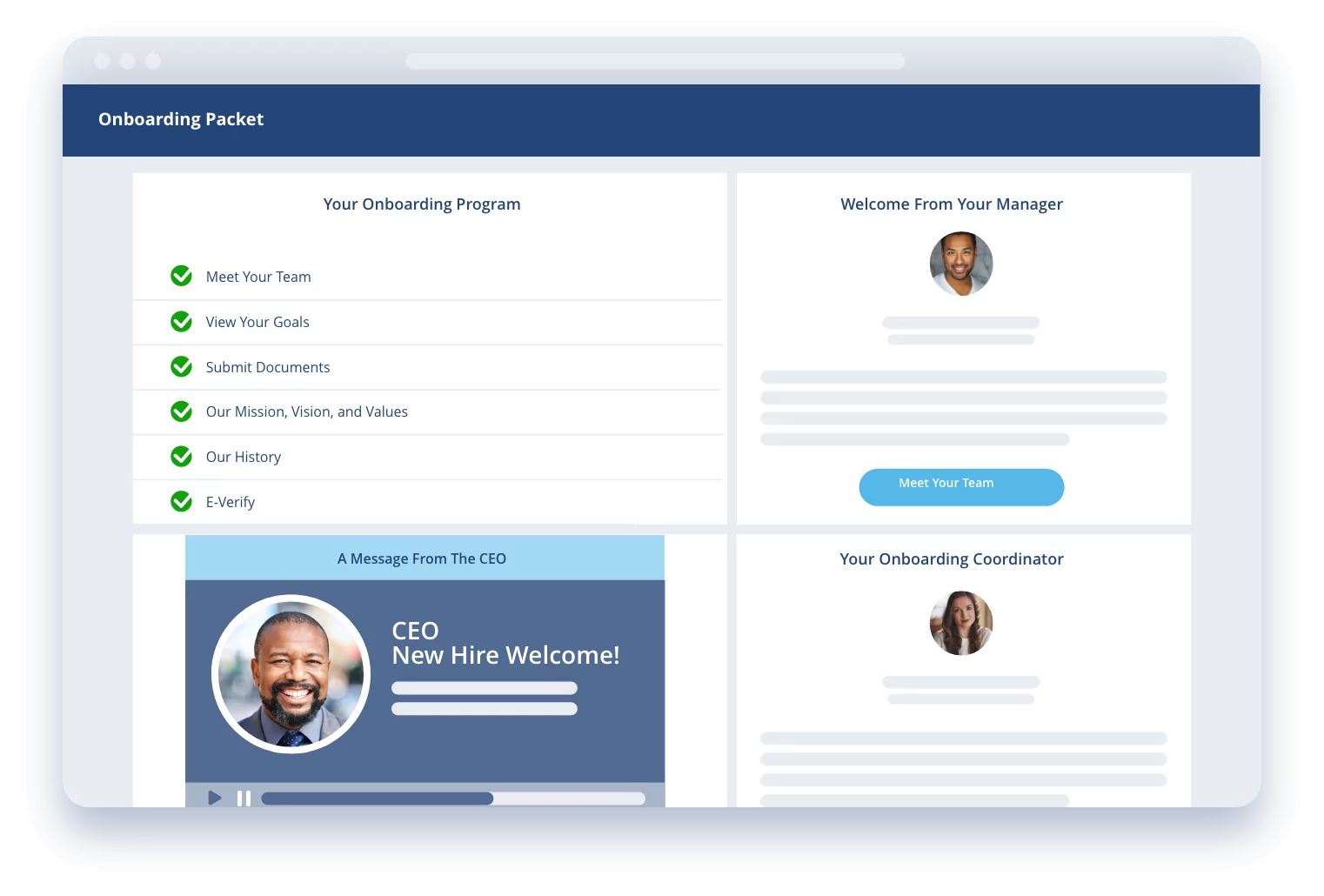This post on onboarding systems was published in May 2018 and was updated in September 2023 with new information.
How Do Onboarding Systems Work?
The benefits of an organized new employee onboarding process are no secret. Statistic after statistic proves the value of onboarding:
- Onboarding can increase employee engagement by up to 54%.
- Onboarding programs have increased retention by as much as 82%.
- Onboarding can boost new hire performance by up to 50%.
It’s not the obvious benefits of onboarding that hold organizations back from implementing programs that work. It’s the necessary time, money, and manpower that keep leaders and their new hires from a highly engaging first few weeks on the job. That’s where onboarding software comes in.
Did you know that onboarding can boost new hire performance, retention, and more? Those are just a few reasons why you need an onboarding system:What is Onboarding Software?
Onboarding systems are technology that helps employers facilitate a smooth transition for new hires. Implementing an onboarding system like this helps managers and leadership address the needs and concerns of their new hires without placing too much administrative burden on HR or managers. It also standardizes the process, which means your new hire introductions are consistent and appropriate for the role. Finally, it assists with compliance, ensuring you don’t lose or misfile important new hire information.
Often, employee onboarding software features a digital dashboard that allows talent acquisition teams to easily communicate with one another and track the progress of each hire as they move through the employee onboarding stage of employment. This includes I-9 verification, built-in background checks, and integrations for payroll and benefits administration.
Some software even acts as a connection between the organization’s applicant tracking system and performance management system to provide a seamless transition from candidate to new hire to fully-ramped employee.
For example, an entry-level candidate will receive a full introduction to the company and KPIs, while a tenured, internal hire can focus more on the additional or newly added responsibilities. Meanwhile, the onboarding team won’t have to create a new program to match the candidate, they’ll simply follow the guidelines already established.
Why Adopt Onboarding Software?
Did you know that one-third of employees quit within the first six months? That’s why the first few weeks on a job are critical for both the success of a new employee and their relationship with their new employer. Employee onboarding should equip new hires with everything they need to be successful and help build their connection to company culture. That’s everything from establishing logistical employment standards to explaining unspoken internal collaboration rules.
This can be a tall order, which is why it’s so important to plan a structured onboarding experience. Adopting an employee onboarding system reduces the risk of missing out on crucial steps in the process because it standardizes the program for each new hire while allowing customization for specific job titles and employment levels. An executive hire’s onboarding plan will be different than that of an intern, but both will need to complete some standard new hire paperwork and get an introduction to the company's mission, values, and culture.
HR software for onboarding is equipped with features that make those critical onboarding tasks a breeze:
- Digital New Hire Paperwork: When bringing on a new hire, it can feel like the paperwork never ends. With an onboarding system, employers can house all documents in one place as well as carry information from form to form, reducing time spent keying in redundant information as well as errors. You can also store important documents like job offer letters and skills certifications in the system where they can easily be accessed by HR team members, hiring managers, and the employees themselves.
- Employment Documentation Compliance: Employment compliance is complicated, but an onboarding system can help ensure your organization is using the latest forms while providing thorough explanations and guidance to the employees who are filling them out. From state tax forms to E-Verify, a new hire onboarding system can help your team stay compliant while saving time.
- Background Checks: Background checks are important for keeping your organization and new hires safe and protected, so it is essential that they are handled appropriately. With an onboarding system, background checks are built-in. No more repetitive manual data entry, chasing down authorizations, or internal bottlenecks.
- Automatic Workflows: Using the best onboarding software will allow your organization to set up multiple automated workflows so you can “set it and forget it.” Most software allows the organization to define a process for each role or department, including creating onboarding checklists to ensure no important steps are missed. Once one step is completed, the responsible individual will be notified so they can move onto the next step.
- Goals and Performance Reviews: Do you know how your new hires are doing in their onboarding process? Do they know what they’re expected to accomplish? With an onboarding system, your new employees can set goals that keep them on track with their program, and their managers can conduct 30-, 60-, or 90-day performance reviews to ensure they’re progressing as expected, answer questions, and get them used to the way reviews work at your organization.
Get our New Hire Onboarding Checklist and you’ll never miss a step in the onboarding process again.
Do You Need an Onboarding System? A Checklist
Every business can benefit from an employee onboarding system. It’s not just an excellent tool for ensuring employees’ first days and weeks are welcoming and useful — onboarding solutions benefit your busy HR team, too.
Your need for an onboarding system is even more urgent if any of these situations are familiar:
- Bringing a new hire on board drowns your HR team in time-consuming tasks, like sending, tracking, checking, and filing paperwork, instead of welcoming and working with the new employee.
- You work in a compliance-heavy industry.
- You’re experiencing onboarding hiccups (for example, forgetting to send a background check or missing the I-9 deadline).
- Your company experiences high turnover among new hires.
Onboarding software saves you time and money, allowing you to focus on building connections with new hires that lead to better employee retention. Use this checklist to see if onboarding software is the missing link your company needs to streamline your onboarding process:
- My organization needs a structured onboarding plan.
- I prefer that my employees complete onboarding tasks electronically and before their start date, if possible.
- I need help managing I-9, W-4, and state tax documents and a more secure platform to store them.
- My employees work in job-specific areas that make communication difficult (in the field, at machines, etc.).
- I need to touch base with my new hires more frequently.
- I have issues managing onboarding scheduling.
- My candidates and employees would respond positively to a mobile-friendly platform.
- My team spends hours entering candidate information into company logs and databases.
- I need assistance conducting background checks and double-checking verifications.
- I could save time by automating tasks, reminders, and deadlines and assigning new hire goals.
- I go through a lot of paper in my various onboarding record-keeping tasks and in onboarding packets.
- I’d like to integrate my performance management solutions like goal-setting strategies and performance feedback with my onboarding process.
- My organization would benefit from insights from real-time reports on how my new hires are performing.
- My new hires would benefit from an employee portal where they can complete paperwork, meet their new team members, and learn about company culture.
The more boxes you checked on the list above, the more your organization could benefit from onboarding software.
Looking for a new onboarding system? Get ClearCompany’s Onboarding System Buyer’s Guide and find the best-fit solution for your organization.
The ClearCompany Onboarding Difference
ClearCompany’s Onboarding software organizes all your documents into one easily accessible platform so you don’t have to search through drives and file cabinets to find them. Eliminate paperwork and introduce pre-boarding for a seamless onboarding process.
ClearCompany also offers mobile capabilities on our onboarding software, making it easy to manage the onboarding process on the go. It gives onboarding managers the ability to connect with new hires before they start and gives new hires access to a self-service portal where they can easily complete onboarding tasks.
Your new hires will be able to access ClearCompany’s Onboarding system to find their goals, assignments, and various onboarding packets all from the same space. The process requires minimal effort on your part, and you save time spent on assigning tasks and checking in about completion.
These features, while critical, are not standard in every onboarding system or platform. Finding the right one for your organization requires research and an understanding of your company’s onboarding process — currently and ideally.
ClearCompany’s Employee Onboarding software has perfected these features and then some. If you’re interested in seeing how our tool can help improve your program, schedule a demo with us today.


